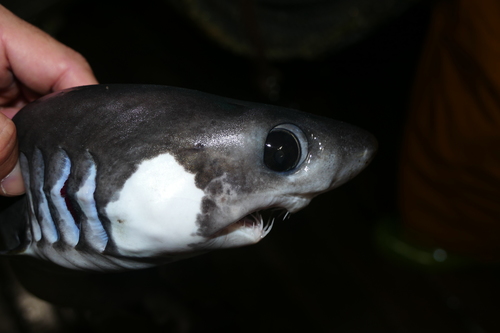
Crocodile Shark
The Atlantic bluefin tuna (*Thunnus thynnus*) is a majestic and powerful fish, renowned for its size, speed, and commercial value. It's a highly migratory species, playing a crucial role in the marine ecosystem. This magnificent creature faces significant challenges due to its high demand.
8 13 years
Lifespan
110 cm
Length
Near Threatened
Conservation Status
43 km/h
Swimming speed
Carnivorous
Diet
Highly Migratory
Migration
Appearance Overview
The Atlantic bluefin tuna is renowned for its large, streamlined body, built for speed and endurance.
Color
Dark metallic blue above, silvery-white below
Body shape
Torpedo-shaped, fusiform body
Fins
Two dorsal fins, the first depressible into a groove; small finlets running from dorsal and anal fins to the tail
Keel
Strong lateral keel on the caudal peduncle
Length
Up to 13 feet (4 meters)
Weight
Up to 2,000 lbs (907 kg), though typically smaller
Diet
Carnivorous, feeding on a variety of fish (such as herring, mackerel, and bluefish), squid, and crustaceans.
Feeding Behavior
Highly active predator, using speed and agility to hunt. They are also known to cooperate in groups to herd and capture prey.
Social Behavior
Forms large schools, especially during spawning season. They are highly migratory, capable of crossing entire oceans.
Commercial Relevance
Extremely high value, particularly in the sushi and sashimi markets. It is one of the most commercially valuable fish species.
Conservation measures
International fishing quotas, size limits, and seasonal closures managed by organizations like ICCAT. Marine protected areas are also used.
Status
Varies by region; Western Atlantic stock: Endangered, Eastern Atlantic and Mediterranean stock: Near Threatened (improving)
Threats
Historical overfishing, particularly for the sushi market, remains the primary threat. Bycatch in fishing gear targeting other species is also a concern.
Habitat Distribution
Depth Range
0-1,000 meters (3,280 feet), but most commonly found in the upper few hundred meters.
Geographic Range
Western and Eastern Atlantic Ocean, including the Mediterranean Sea. Historically also found in the Black Sea.
Preferred Environment
Pelagic, open ocean waters, both temperate and subtropical. They prefer areas with specific temperature ranges and often follow ocean currents.
Reproduction and Life Cycle
Breeding Habits
Spawns in specific areas, primarily in the Gulf of Mexico (Western stock) and the Mediterranean Sea (Eastern stock). Spawning typically occurs in spring and summer.
Development Stages
Eggs are pelagic (free-floating). Larvae develop rapidly, feeding on plankton. Juveniles grow quickly and join schools.
Fecundity
Highly fecund; females can release up to 30 million eggs per spawning season.
Maturity Age
Western Atlantic stock: matures around 8-12 years; Eastern Atlantic stock: matures around 4-5 years.
Faqs about Crocodile Shark
How fast can Atlantic bluefin tuna swim?
Atlantic bluefin tuna are among the fastest fish in the ocean, capable of bursts of speed up to 40-60 mph.
How long do Atlantic bluefin tuna live?
They can live up to 40 years, although this is rare due to fishing pressure.
Are Atlantic bluefin tuna warm-blooded?
Atlantic bluefin tuna are warm-blooded, unlike most fish, which allows them to maintain a higher body temperature than the surrounding water.
Do Atlantic bluefin tuna migrate?
Yes, they undertake extensive migrations across the Atlantic Ocean for feeding and spawning.
What organization manages bluefin tuna fishing?
ICCAT (International Commission for the Conservation of Atlantic Tunas) is the primary organization responsible for managing bluefin tuna stocks.
Whats is the record weight of Bluefin Tuna
The record weight is over 1496 pounds.
Copyright @ Nature Style Limited. All Rights Reserved.
 English
English